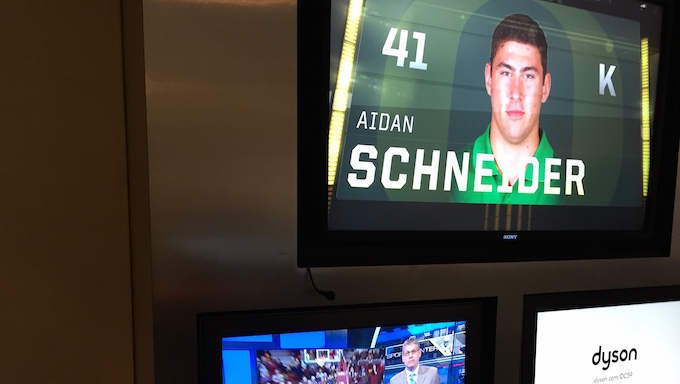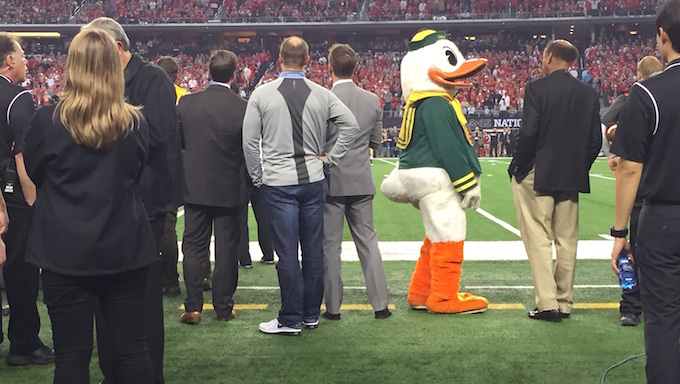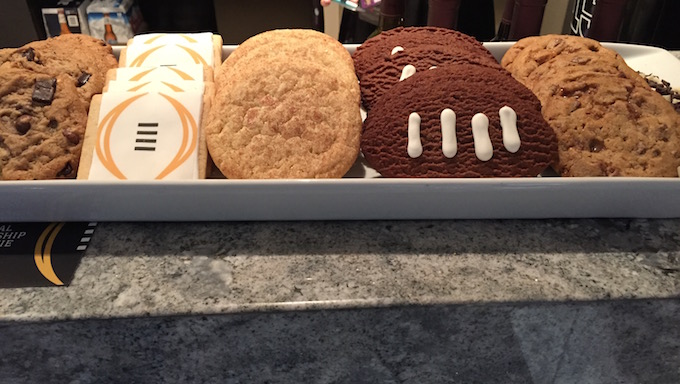
Here’s the best tip for visitors to AT&T Stadium in Arlington who want a pleasant and affordable experience: The Lincoln Square shopping center at the corner of Collins and I-30 will let you park your car for free, so long as you spend $40 at one of their shops or restaurants, and leave the receipt on your dashboard. It’s 0.7 miles to the stadium, and you can enjoy a few drinks at Baker Street Pub, some Hospitaliano! at the Olive Garden, grab some khakis at the Gap, or scour the shelves at Half-Price Books for well-loved copies of, say, Erica Grieder’s Big, Hot, Cheap, and Right and Nate Blakeslee’s Tulia: Race, Cocaine, and Corruption in a Small Texas Town, and then walk to the stadium (or take the $5 shuttle, if you’re feeling lazy). Down the block on Collins Street, mere steps away from Lincoln Square, you’ll see the car wash and the Pep Boys asking exorbitant prices, $70, $85 for oversized cars, and with a belly full of pasta or Shiner, rest secure that you know a secret about how to do AT&T Stadium right.
But there are lots of ways to do AT&T Stadium, as I learned last night. I was invited to attend the College Football Playoff National Championship game by a publicist at AT&T, who was looking to promote something called LTE Broadcast by offering a few tickets to sports and technology journalists who could get to the stadium for a demo, and seeing that I write about both, I accepted. I was interested in the new technology, because as a journalist I’m interested in just about everything, but if I’m honest with you, I wasn’t going to turn down a free ticket to the game.
I’ve been to AT&T Stadium for football games before, mostly to see the Chicago Bears play the Cowboys. On those occasions, I’ve shelled out somewhere in the neighborhood of $200 a ticket to sit in the upper nosebleeds. I’m intimately familiar with section 402, a height from which the extremely large men on the field look like ants aligned in curious formations, and from which you find your attention divided between the field itself, and the massive jumbotron (the world’s largest, at the time it was built!) that Jerry Jones hung from the roof of the place right over the middle of the field. As live, in-stadium football experiences go, once you get used to walking up all those stairs and to seeing six-foot-eight, 320-pound offensive linemen look like dollhouse figurines, it’s actually pretty fun—you’re sitting near a bunch of other people who have enough money to go to a game, but not enough money to afford good seats, passionately singing “Bear Down, Chicago Bears” to the consternation of your neighbors, and heckling Tony Romo from a distance so great that he could never possibly hear you.
That is the experience for the sort of fan who can afford a $200 splurge once a year or so: Neat, but distant, and entirely focused on football. Why else would you even be there?
When I claimed my ticket at Will Call on Monday night, I was presented with a fancy, oversized ticket with foil stamping and words like “premium entrance” and “suite” on the bottom. Everyone I presented it to called me “sir,” and I was guided to the EL30 suite.

“EL30” means “Event Level, Suite 30.” And the “Event Level” suites are a very different experience from Upper Nosebleedia—in ways both sublime and surprisingly alienating. “Event Level” means you are about two feet below the surface of the field, with the sideline directly in front of you. You’re maybe twelve yards from the edge of the actual playing field.
The suite has a closet in which you can place your jacket when you come in. Quite different from being in a cramped seat with nowhere to put anything. The suite is catered, and the food’s pretty good: nothing too fancy, but things like homemade mac & cheese, some BBQ sliders, and a big plate of shrimp cocktail. There’s a stocked fridge with beer and soft drinks, a few snacks and sweets—a decent spread. There are tables and chairs both within the interior of the suite and outside of it, next to the sideline. And there are three TV’s on the wall—one tuned to the jumbotron, and the others (at least last night) tuned to various ESPN channels.


Those televisions come in handy, because wen you’re actually in the suite, a lot of the time, you can’t really see the field. Your view is of the backs of a lot of people’s heads. Maybe a giant duck.

There are fourteen prime seats just above the suite that come with it, which holds twenty people. That means that at least six of the people in the suite aren’t really at the game—they’re in what’s basically a small studio apartment right next to the field, watching the game on TV.
But that’s largely okay, because the suites are about something other than offering the most incredible football-watching experience money can buy. According to SportsBusinessDaily, the suites cost more than $350,000 a year. The people who can afford a suite, at that price, are pretty strictly limited to, say, corporate sponsors like AT&T. And AT&T invited someone like me to hang out in the suite not because they knew I’d be super pumped to watch Marcus Mariota throw laser-like passes for his receivers to drop, but because they wanted to show off their LTE Broadcast technology. At the neighboring suites, it was the same thing—this was an exciting environment to network from, to promote projects or make deals, but the suite experience is as much about giving people a comfortable place to ignore the football game from as it is giving them the ideal environment to watch it.

So about that LTE Broadcast. Basically, the problem with live sporting events (magnified by the glacial pace at which football moves on the field) is that your own couch is the ideal environment from which to watch a game. At home, the angles of the field are impeccable (thanks, camera guy in a very tall chair who gets driven around on the sideline). There are knowledgeable, charismatic announcers (plus Joe Buck) who provide live analysis of the game and you can jump to the RedZone Channel or a rival’s game instantly. Then of course there’s instant access to ever-important stats to keep up with your fantasy team; snarky jokes from funny people watching the game on Twitter; and the ability to flip to a different game if things are slow on the field, or if they’ve cut to commercial. At the stadium, you spend at least $200 for the privilege of spotty cell signal and getting beer spilled on your coat by a stranger.
The reason AT&T let me sit in their very nice suite at the stadium was because their new technology—LTE Broadcast—aims to fix that, and they wanted me to tell you about it. It’s something that could legitimately improve the stadium-going experience dramatically. Here’s the simple version of how it works: LTE is a spectrum of the airwaves that our phones use to communicate. If you’re at a stadium right now, and you want to check out the WatchESPN app, you have to send a signal from your phone to the cell tower, which attempts to communicate with ESPN’s servers, and then send it back to you. There are at least 80,000 other people trying to do the same thing, through the same cell tower. This means that the network is jammed, and nobody can so much as send a text message.
LTE Broadcast uses a dedicated percentage of the LTE spectrum in a given area (say, AT&T Stadium) in order to send out a specific stream of content to anyone who can access it. At AT&T Stadium on Monday night, during the demo they offered at the National Championship game, that meant that I could watch the ESPN broadcast live on the phone (Michael Wilbon was eating some chips in that control room they were inexplicably showing on ESPNu!), with crisp quality. It doesn’t matter if one person or 80,000 people are receiving that broadcast—the signal is strong and clear, like turning your radio to 101.1. If you’re receiving the broadcast, it comes in cleanly, and it never uses more than the (say) ten percent of the LTE network they’ve dedicated to it.
That’s a good start to make the stadium experience better. If half the people in the stadium are looking at the stats stream and listening to the audio from the announcers on their phone—or, say, watching to see if the Eagles blow their week 17 game so the Cowboys can clinch the division—then that frees up the LTE network for the other half to Instagram selfies from their seats, or Tweet hilarious Romo jokes. It allows everyone to have access to the sort of experience that they have at home—or in the $350,000 a year event-level suites.
Let’s just admit it. When it comes to watching football in 2015, the experience to beat is the one you can have from your living room. LTE Broadcast technology (which probably won’t be in place at games in 2015, but should be ready for the public pretty soon) brings some of the experience that to the stadium, which might just help justify the ticket prices.








